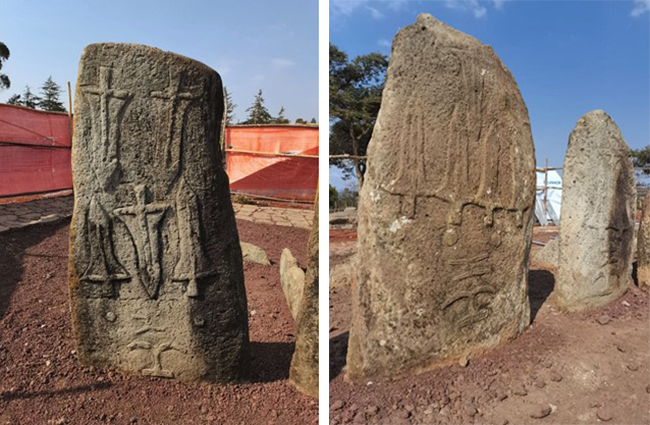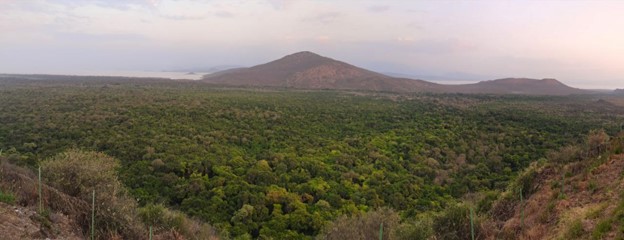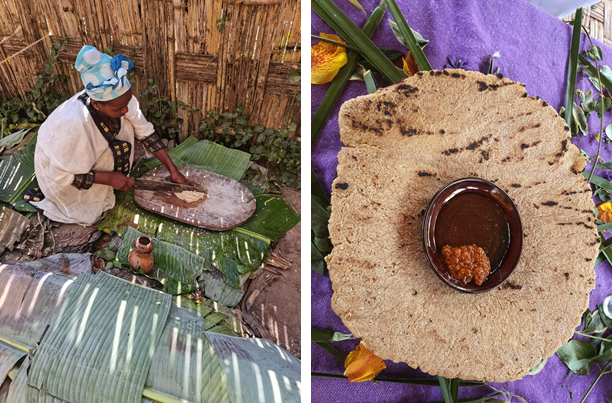Astrobus Ethiopia 2021
May, 2021
—
astrobus
A conversation between Yabebal Fantaye, founder of Astrobus, and Biljana Ciric on the initiative: Astrobus. Astrobus will be conducing its third series of workshops in collaboration with As you go…roads under your feet, towards the new future Project and we have decided to get to know them better as well as better understand their modes of working.
Just before conducting this interview, Yabebal and a small group of peers went on a research trip to prepare for the upcoming Astrobus series that will be activated in 2021 in Lower Omo Valley in the Southwest of Ethiopia. The field notes of this research trip are also published alongside this conversation, with the workshops themselves to be later shared through journal, in a way of finding ways to learn from local communities.
Biljana Ciric:
How was Astrobus initiated and how would you situate [the] Astrobus initiative within the local context of Ethiopia?
Yabebal Fantaye:
The idea of Astrobus came in 2015. It was partly inspired by seeing the inspirational pictures from the 1st edition of the SPACEBUS TOUR 2015 held in Senegal from 1-31 March 2015.
In July 2015, a group of Ethiopian Astronomers from all over the world submitted an Expression of Interest with under the project name of Astrobus-Ethiopia for the Office of Astronomy for Development (OAD), which is part of the International Astronomical Union (IAU). The Brief summary of the project in the application was:
“The AstroBus (ABus) Ethiopia project we plan aims to stimulate astronomy education and a culture of scientific thinking in Ethiopia through the use of exciting astronomy activities. This project is inspired by the success story of the 2015 ‘SpaceBus‘ project in Senegal. We believe the idea [of] ‘SpaceBus’ is an effective approach to reach out to the general public in a creative and inspiring way.”
As can be seen from the original project description, the project from the onset has [had] the local context as a major [focal] point – building on top of a successful initiative in another African country. The Astrobus-Ethiopia project won IAU OAD funding in Nov 2015. The original 11 team members were all Astronomers, 9 Ethiopians and 2 from South Africa and Norway. The project was planned for Dec 2015, but the situation in Ethiopia meant [that] we couldn’t materialise it [until] Oct 2017.
The delay gave us extra time to work on the project details, including time to think about the mission and vision. After extensive online and offline meetings, we decided to go beyond astronomy and include all areas of critical thinking. We defined our mission to be: “Stimulating a culture of critical thinking in Ethiopia.”
After securing extra funding from the African Institute of Mathematical Sciences and the Ethiopian Space Science Society, we established an art and technology sub team on top of the original science and astronomy sub-teams.
By collaborating with local non-profit organisations on science, technology, and art, and by partnering with different Universities, we managed to hold the first Astrobus-Ethiopia event in Oct 2017 in the southern part of the country, encompassing cities such as Addis Ababa, Adama, Hawasa, Dilla, Alaba, and Wolaita Sodo. We chose these places as they are major cities and are relatively easy to travel to. Moreover, we also had an established network to [the] Universities in those localities.

BC:
Why the title ‘Astrobus’?
YF:
The name Astrobus came because the first proposal was aimed to only encompass astronomy and space activities. Despite the project’s reach expanding a lot since then, we kept the name as it still provides the bigger picture of the project – we still need new scientific ideas, innovative engineering, and artistic design to make a bus that will take us to outer space.
BC:
Astrobus was started by yourself and a number of collaborators. Could you talk about the structure of the initiative?
YF:
The idea to have an Astrobus-Ethiopia event in Ethiopia first came because I wrote an email to my Astronomy friends to start writing a project proposal, which was written with significant contribution from every team member.
The project is planned and executed by an ad-hoc group that is established at each event. The main work areas that need to be address for a successful Astrobus-Ethiopia event are:
1. Road Management
2. Science Team
3. Art Team
4. Technology Team
5. Media & Communication
The first event held in 2017 encompassed cities such as Addis Ababa, Adama, Hawasa, Dilla, Alaba, and Wolaita Sodo. [The] second event took place in 2019, traversing cities such as Fiche, Debre Markos, Bahirdar, Gondar, Axum, Mekelle, and Woldiya. Within the two trips we managed to reach more than 12, 000 students from around 70 schools. Our next trip will be in May 2021 to the cities of Arba Minch, Konso, Jinka, and Sawla.
BC:
Astrobus always travels to different places. How do you decide when to undertake the next project?
YF:
[The] ambition of Astrobus-Ethiopia is to reach students from all corners of Ethiopia through its series of events. In the past, the team has travelled to the north and the south of Ethiopia. This year, the team plans to travel to the Lower Omo valley, the south west of Ethiopia, which is known for its extraordinary cultural diversity; approximately 8 ethnic groups; and striking ecosystems including grasslands and pristine forests, and other natural wonders. Omotic-speakers are endemic to the south Omo and include the Ari, Maale, Daasanach, the Hamar-Banna. The region is home to the vast omo park, and the massive Gibe III dam built on the Omo river.

BC:
What are the challenges that you usually face executing [a] project of this kind (funding, language barriers, local schools – private, public, etc…)?
YF:
The main challenges we face in organising the Astrobus events are primarily securing enough funding, establishing a functional local organising committee in the localities we travel to, and finding event locations. Moreover, due to the fast-changing nature of the Ethiopian social and political situation, ensuring [the] safety of our team during the trip and having legal permission to securely hold the event is a constant challenge.
BC:
For the upcoming workshops in May, which will be done in collaboration with [the] As you go… Project, you were able to conduct research trip before undertaking [the] workshops. Can you discuss the difference this had from other trips in the past?
YF:
Yes – the seed funding for this year’s Astrobus-Ethiopia event is obtained from the As you go… Project, which is also supported by the CURTAIN Project (of Rockbund Art Museum). We also raised some funding from the Ethiopian Space Science Technology Institute and Ethiopian Space Science Society.
What makes this year’s event preparation different is that we were able to do a research trip to learn about the cultural context of the areas we travelled to and had the opportunity to connect with local organisers before the event. The information we collected helped us adapt our science, art, and technology activities to suit the social and ecological context of the people we will meet.
Another new element is how we formed the art team. This year in collaboration with the bruhartclub, we conducted an open call to artists to propose events. We had a total of 165 applications, from which we selected 10 applicants from Visual Art, Creative Filmmaking, Photography, Street Art, Literature, Poetry, Music, Fashion design, Architecture, Metal Art, Gaming Video Editing, and Graphics Design.

Pre-trip Summary
Feb 2021
The Drive

On the way to the destination stops, we visited the following areas and our journey tracks below:
· Left Addis Ababa at around 7am. We got stuck in traffic, and we were only able to leave Addis around 8pm.
· Stopped at Tiya to visit the Tiya Stelles (Tikel Dingay), where we spent 0.5-1hr.
· Stopped for breakfast/lunch at Butajira around 11am.
Details of the expenses can be found in this google sheet.
Objective of the Trip
The main goal of the pre-trip was to study the current social and political situations in the four main destinations of Astrobus-Ethiopia 2021: Arba Minch, Dorze, Konso, and Jinka. We wanted to understand the cultural context while paying particular attention to the following:
· What do people eat? What type of music do they listen to? How do they dance?
· What are their main economical tools?
· What are their histories?
· Who are their heroes?
· What are the parts of their culture they are most proud of? What elements do they want other people to know about?
· What are the main concerns of the young people? Economical? Situational?
· Who are the people and initiatives that are doing well in the area/region?
· Who are the local role models?
In addition, the trip had another main objective of setting up local organisers, who help facilitate the event, by reaching out to Schools, Universities, and local administrative bureaus. Finding local organisers, whoever volunteers and lives in the area, is key to the success of the project. They assist in contacting schools and other organizations necessary for coordination of the event.
In all places, the majority speak Amharic, so there is no issue in communication.
Everywhere in our pre-trial, we used local guides to more intimately understand the history, culture, and values of the people in the localities we visit.
All the communities we visited are located within a town, city, or in the suburbs, which means they are easily accessible. The roads to all visited areas are in very good condition, with no need for a special car. The road from Addis to Jinka is asphalt, and of good standard.
Two people embarked on research trip in February: Yababel Fataye and Sinkneh Eshetu.
Both of the main objectives above were reached.
Places and People
Tiya (ጢያ)

Tiya Stele: 500-600 year old decorated gravestones. There has been very little research on these stones, and the many questions regarding the people who built it remain unanswered. The symbols in the stele include: swords, pillows, enset (a false banana tree whose trunk provides the staple food of the region), and a few others which are not yet well understood.
The is an archaeological site in central Ethiopia located in the Garage Zone of the Southern Nations, Nationalities, and Peoples Region south of Addis Ababa. It is along the way to Arba Minch with an easily accessible road.
Arba Minch

Arbaminch (meaning 40 springs), is the water house of the country. It has countless springs that are a clean source of the city’s drinking water and hosts two lakes – the Abbaya & Chammo Lakes – connected by what is named the God Bridge. It has one of the most beautiful forests and grasslands. The nech sar is one of the iconic national parks of Ethiopia.
Dorze


The Dorze people, a small tribe of around 50,000, who speak the omotic langange: the Dorze language, are famous in Ethiopia for their exceptional weaving skills, delicious food, and particular style of dance and music. They reside in highland villages near the cities of Chencha and Arbaminch. Despite being very small in number, they are all over the country and produce most of the nation’s traditional cotton cloths.
Konso

Konso Villages. The Konso Village, with its special cultural landscape is a UNESCO world heritage.1“Konso Cultural Landscape,” World Heritage List, United Nations Educational, Scientific and Cultural Organisation | World Heritage Convention, https://whc.unesco.org/en/list/1333/ The villages that date back 21 generations (400 years) are fortified settlements in the Konso highlands of Ethiopia with stone-walled terraces. Generation poles, which represent the village’s 19 year cycle power transition, provide [an] accurate dating of the village. The community open houses provide night shelter for the youth who take turns sleeping there to ensure the security of the village.
The Konso people are also known for their excellent farming strategies, one example being their multi-season crop management that allows them to collect two to three yields from a single seeding.
The Konso speak the Konso Language, similar to the Oromigna language, which is spoken by the larger Oromo people.
Hammer

At Hammer, a Bull jumping Ceremonial event.
Hammer, the name for the place and its people, are well known for their strong cultural and social cohesion. They are a small population of around 75,000 and speak the Hamer-Banna language. The bull jumping ritual ceremony represents a rite of passage for a man to own properties, form a family, and become a full member of the community. For women, it is the ability to bore a child.
Jinka

Meeting with an Aari family to learn about their culture.
Jinka, a city in the lower Omo valley with a multi-ethnic society. The Aari people are the main tribe in the region, speaking the Aari language which is an Omotic language. The Aari people have one of the cleanest compounds and their houses [are] well kept – an incredible sensitivity to beauty and sanitation. They are known for their blacksmith and pottery skills, and their excellent music wins many hearts in the country, recognised for its exceptional tune and vibe.
Ari people

A traditional Ari woman painter observing us leaving her compound after she demonstrated the process she uses to make colors to us, and then painted her favourite pattern.
Questions: Where do Ari people leave [to]/live? What is [the] social structure?
General observations
· Temperature is hot but not humid until you reach Arba Minch, and so there is largely no need for air conditioning.
· The road from Wolaita Sodo to Arba Minch is very good.
· Tiya (ጢያ) castells are a source of historical, archaeological, forensic, pattern reading for the project context.
· There may be a plan to decode 100 symbols from tiya tikel dengaye (note: ask for the Southern people to name what it represents for them, then analyse data and make an inference).
· Gamo and Gofa zone.
· Dorze is in a Gamo zone. The drive from Arba Minch is a pista road on the mountain.
Project Ideas
With the assumption that we could motivate, inspire, and connect better with our audience if the things we do are relevant to their needs and interests, we brainstormed with the local communities. Some of the points and suggestions forwarded are as follows (Astrobus travellers may consider to link their projects with any of these):
Arba Minch
· Netchsar National Park
1. Counting and classifying the Arba Minch forest trees
2. Counting and classifying the wildlife at Netchsar?
· Banana and other products
1. Identifying disease in some major crops such as Banana
· Waste disposal
1. Handling and transforming domestic waste such as plastic bottles
· Unemployment, Moral Development, and Entrepreneurship
1. Motivating the spirit of moral leadership, entrepreneurship, and innovation
· Sport
1. Creating physically and mentally healthy generation
· Music
1. The technologies behind making and enjoying music
· Food
1. Traditional foods
2. Healthy foods
Dorze
· Architecture
1. Innovations in traditional architecture
2. Bamboo technologies
· Weaving
1. Technologies in cloth making, such as weaving and dying
2. Fashion design
· Food
1. Inset
· Music
· Pottery
Konso
· Architecture and cultural landscape
· Human Origin
1. Human origin and distribution (genetics)
2. Cultural exchange
3. A child innovator – who made interesting attempts at inventing
Jinka
· Art – working with the traditional women artists, probably using a different materials
· Craft – blacksmith
· Brewery
Sawla
Not visited
The Food
· ኵርኵፉ: ማሽላ (በቆሎ እኞኪ) ፣ ጐመን
· ቡላ ፍርፍር: ውሃ እየተርከፈከፈ ዱቄቱ እየታመሰ ፍርፍር ይሆናል
· ፎሰሴ: አደንጋሬ፣ ጓመን ፣ በቆሎ
· ቁጢ (ሃይታ ቱኬ) ሻይ: ነጭ ሽንኩርት፣ ድምብላል ፣ ቀይ ሽንኩርት፣ ጭቁኝ ፣ ጨው
· ሙቿ: ቡላ ፍርፍር
· ብላንዶ: ቆጮ በበላቄ
· ባጭራ: ቆጮ በወተት
· ኤፔላ ቅቤ ፍርፍር

Dr Yabebal. Fantaye is an Astrophysicist and a data scientist.
[1] “Konso Cultural Landscape,” World Heritage List, United Nations Educational, Scientific and Cultural Organisation | World Heritage Convention, https://whc.unesco.org/en/list/1333/
